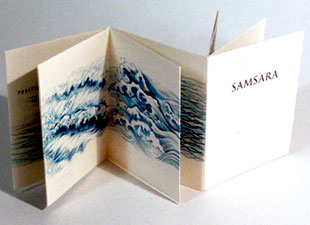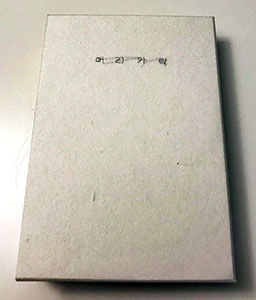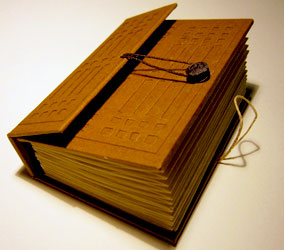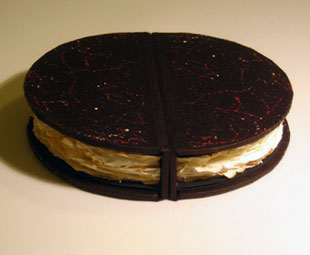| |
|
Sun Young Kang
~New York
|
Share this page: |
| |
|
Sun-Young Kang received a BFA in Korean Painting from Ewha Woman's University. After working briefly as a children's book illustrator and designer, she moved to the US and earned an MFA in Book Arts/Printmaking at The University of the Arts in Philadelphia.
Sun Young Kang: "My working process is always repetitive, to represent every single moment as a timeless space in between absence and presence, as well as providing a visual/invisible concept of their interrelationship. The effect of light and shadow, and the delicacy in the strength of thin paper are most commonly used in my work as a metaphor of the inseparability of life and death, as well as an installation device to create two conceptual spaces-one side and another in the same space." |
| |
|
Samsara
By Sun Young Kang
Philadelphia, Pennsylvania: Sun Young Kang, 2005. Edition of 400.
1.75 x 1.375"; 12 pages. Miniature. Inkjet printed with hand drawn images. Modified dos-dos structure. One sheet folded to form 12 pages.
From the book: "The material world was a place fragmented and constantly changing; this changing aspect of the universe came to be called samsara."
Wikipedia (5/3/12): "In modern parlance, samsara refers to a place, set of objects and possessions, but originally, the word referred to a process of continuous pursuit or flow of life. In accordance with the literal meaning, the word should either refer to a continuous stream of consciousness, or the continuous but arbitrary drift of passions, desires, emotions, and experiences."
$10
|
 Click image for more
Click here for the link to Instagram
Click image for more
Click here for the link to Instagram |
| |
|
|
| Sun Young Kang SOLD / Out of Print Titles: |
|
| |
|
머리카락HAIR
By Sun Young Kang Buffalo, New York: Sun Young Kang, 2018. Edition of 20 + 1 AP.
Size: 85” x 5” x 3” open; 3” x 5” x 0.5” closed. Accordion structure. Two layers of paper: one of text and one as protection of the back side of the sewn text. Embroidery using artist’s own hair on handmade Japanese paper. Materials: hair, Japanese paper, museum board, transfer print. Text in Korean with English translation on the colophon. Signed and numbered on the colophon by the artist.
Sun Young Kang, colophon: "I feel estranged by myself being disgusted by my own hairs on the floor. Once, they were precious as part of me. But once they are shed, I alienate them and even hate them. So, I decide to collect my hairs that I lose as my way of embracing both of the feelings toward myself— the obsession and contempt.”
Sun Young Kang: "Shed hair is no longer physically part of me, but it still contains information (genetic, protein, etc.) that are specifically myself. The only difference is in the loss of physical connection. This piece questions how this common thinking reflects how people relate/connect to each other. As a person who always feels living in between two cultures feeling forever outsider in either place, this thought also reflects how immigrants are often separated from their families, so that emotional connection is weakened or even lost over time and the people become more isolated from their homeland that way."
(SOLD/Out of Print) |
 Click image for more
Click image for more
Click here for the link to Instagram |
| |
|
Memories Unfolded
By Sun Young Kang
Philadelphia, Pennsylvania: Sun Young Kang, 2011. Edition of 10 + 1 AP.
3 x 2.25"; 27 pages. Accordion fold from back pastedown. Shadow book. Paper cutting. Colophon on back pastedown. Paper-covered boards with cutout door designs in matching paper tipped on. Thread and button closure. Laid in archival phase box with velcro closure.
This is a shadow book meant to be read under a lamp or spot light in a dark space.
Sun Young Kang: "I have created this shadow book with paper-cut-out images of Korean traditional doors. The process of cutting the pattern of the doors to create shadows recalls my memories of my grandmother in her old house. When I was inside, I could see the shadow of Grandmother cast on the paper doors from outside. Grandmother's presence as a shadow on the door has remained a strong image in my mind. Unlike many other doors, the traditional rice paper door does not totally block the inside and out from each other. It only creates the concept of this side and the other while simultaneously connecting them to each other. When this accordion book is unfolded, the pages are shaped as closed, connecting the memories of my Grandmother, who is now in the other side, with myself in this world."
(SOLD/Out of Print)
|
 Click image for more
Click image for more |
| |
|
The Story of Thousands of Stars
poem by Suk Bum Hong
Philadelphia, Pennsylvania: Sun Young Kang, 2005-2009.
Edition of 10 + 2 AP.
1Two books: 4.5 x 2.25"; 52 pages. Hand drawing. Computer-manipulated and inkjet printed photograph. Handmade paper for text block. Boards covered in Korean Warahani paper with inkjet printed image. Case bound with optic binding.
Sun Young Kang: ""The name Man-Byul, meaning 'thousands of stars' in Korean, was created by combining the first and last syllables of Man-Nam (meeting) and Yee-Byul (farewell) respectively. Man-Byul is the story of our life, combining both the happiness and joy of 'meeting' with the inevitable sorrow of 'farewell'...."
Sun Young Kang in "To someone who is reading these words about the Story of Thousands of Stars": "The words in this book written in Korean form a poem or a short statement written by my old friend. This friend has been studying astronomy and his favorite part of his study was looking up the stars. But before being in science, he wanted to be a writer....He used to write many poems.... [some] of them were about star[s] to talk about love. I think he meant more romantic love...but when I read [The Story of Thousands of Stars] I understood it as human connectivity and the nature of human life, so I asked his permission to use the words for my book....
"Korean has syllables like English but [they] can be separated and still readable. And each syllable doesn't always have meaning like Chinese but it is still readable and understandable when separated in order....I actually used this trait of Korean and separated all the syllables and repositioned them to use each syllable as an image. So each syllable is a Star in this book. Then I connected each with the pencil line to provide the original order and also to make a constellation. So, if you are a Korean speaker and if you read each syllable in the order, you can read and understand.... But if you just look quickly without knowing the meaning, it is more like images than word.
"Each page normally has one phrase of one short sentence.
"Conceptually, each star is connected to each other and they make their own story just like we human beings are all invisibly connected and create our stories through this life. There are so many stories in the sky like many pages of the book and all the pages become the whole sky, the circular shape of the book. So, I wanted each volume to form the circular shape like sky when you open the book. (I don't know the actual shape of the sky but it is circular in my mind. Also, circular shape is the perfect shape for me because it never begins and never ends.)
"Each of the two volumes can be separated as meeting and farewell respectively, but they are originally together and become another circle again. I believe that our life is composed with two ideas, which are meeting and farewell, birth and death, happiness and sadness and etc."
(SOLD/Out of Print) |

Click image for more
|
| |
|
| |
|
Page last update: 09.10.2021
|
